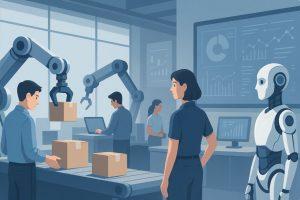Amazon, one of the world’s largest and most influential tech companies, has entered 2025 with a difficult but strategic decision laying off thousands of employees across various departments and regions.
These job cuts have sparked widespread concern and debate, particularly among professionals in the UK. The question now on many minds is: why is Amazon laying off employees, and what does this mean for the future of the tech industry?
What Is Triggering Amazon’s Recent Job Cuts?
 The layoffs currently taking place at Amazon are rooted in the company’s need to realign after a period of rapid expansion during the COVID-19 pandemic. In those years, Amazon ramped up hiring to match the surging demand for online retail and digital services. However, as the world returns to pre-pandemic behaviour, and with inflation putting pressure on consumer spending, Amazon finds itself overstaffed in several areas.
The layoffs currently taking place at Amazon are rooted in the company’s need to realign after a period of rapid expansion during the COVID-19 pandemic. In those years, Amazon ramped up hiring to match the surging demand for online retail and digital services. However, as the world returns to pre-pandemic behaviour, and with inflation putting pressure on consumer spending, Amazon finds itself overstaffed in several areas.
Furthermore, the company is now under increased pressure to demonstrate profitability after years of growth-focused spending. Amazon is cutting costs and tightening operations, choosing to scale down or shutter non-core initiatives. These job cuts are not random; they reflect a more focused shift in Amazon’s long-term strategy and are designed to make the company leaner and more efficient.
How Has the Tech Industry Downturn Influenced Amazon’s Layoffs?
Amazon’s decision doesn’t exist in a vacuum. The broader tech sector is undergoing a significant correction. Companies that once expanded aggressively are now facing the consequences of market saturation, falling ad revenues, and shifting investor expectations.
Many of Amazon’s peers such as Google, Meta, and Microsoft have also implemented layoffs in 2025, citing similar reasons: slowing revenue growth, increased operational costs, and the rapid integration of artificial intelligence. This wave of tech industry layoffs has had a ripple effect across the global job market, and Amazon’s decision is part of this wider pattern.
For Amazon, aligning itself with market expectations has become essential. Investors are demanding more accountability, efficiency, and a clear path to profitability. In this climate, reducing the workforce is viewed as a necessary step to stay competitive.
Is Amazon Restructuring Its Business Operations?
Yes, and the restructuring is both extensive and deliberate. Over the past year, Amazon has been evaluating the performance and future viability of its various departments. The result is a sweeping internal reorganisation aimed at eliminating duplication, consolidating roles, and winding down projects that no longer align with the company’s priorities.
For example, Amazon has slowed or paused expansion plans for its physical stores, such as Amazon Fresh and Go. Divisions like Amazon Alexa, once a priority, are also under review, with reports suggesting cuts due to limited monetisation potential. Even Amazon’s retail and logistics divisions historically the company’s backbone are being optimised to reduce excess capacity.
These changes mark a strategic pivot. Rather than focusing on rapid growth, Amazon is turning its attention to operational efficiency and sustainability.
What Role Does Automation and AI Play in Employee Redundancies?
 The growing influence of automation and artificial intelligence cannot be ignored in any discussion about layoffs. Amazon has been a leader in deploying AI technologies in its warehouses, logistics network, and customer service channels. These technologies are not just enhancing operations they’re replacing the need for many human roles.
The growing influence of automation and artificial intelligence cannot be ignored in any discussion about layoffs. Amazon has been a leader in deploying AI technologies in its warehouses, logistics network, and customer service channels. These technologies are not just enhancing operations they’re replacing the need for many human roles.
In warehouses, robots now handle inventory management, order picking, and packing with speed and accuracy that far exceeds human labour. In customer support, AI-driven chatbots and voice assistants manage a significant volume of inquiries without human intervention. Even supply chain forecasting, once reliant on human analysts, is now largely automated using predictive algorithms.
As Amazon leans more heavily on these innovations, the company requires fewer employees to perform manual, repetitive tasks. While this transformation boosts efficiency and reduces costs, it also raises difficult questions about the future of work in an AI-driven economy.
Are Amazon Layoffs Affecting the UK and London Workforce?
While most of Amazon’s job cuts are concentrated in the United States, the UK has not been spared. In London and other major cities, corporate roles in departments like marketing, technology, and HR have been affected. Amazon’s fulfilment centres in various parts of the UK have also seen staffing reductions, reflecting the company’s global efforts to tighten operations.
The layoffs come at a time when the UK economy is already facing uncertainty due to inflation, interest rate fluctuations, and post-Brexit adjustments. For workers in London, Amazon’s job cuts add to concerns about job security in the technology and e-commerce sectors. While Amazon remains committed to its UK operations, the restructuring serves as a reminder that even major employers are not immune to market pressures.
How Are Employees and Investors Reacting to the Layoffs?
The reaction to Amazon’s layoffs has been mixed. Among employees, there is understandable anxiety and dissatisfaction. Many workers expressed frustration over what they see as a lack of transparency and support during the restructuring process. Internal morale has reportedly taken a hit, particularly among teams that feel blindsided by sudden changes.
From the investor perspective, however, the response has been far more positive. Markets generally reward companies that take decisive action to protect profitability, and Amazon’s share price has seen a modest rise following news of the layoffs. Analysts have noted that the job cuts, while painful in the short term, could help Amazon return to more stable financial footing in the long term.
Ultimately, Amazon faces the difficult task of balancing stakeholder expectations ensuring that its financial performance remains strong while also protecting its reputation as a responsible employer.
What Are the Long-Term Implications for Amazon’s Business Strategy?
 The current wave of layoffs is a clear indicator that Amazon is rethinking its long-term business priorities. The focus is now shifting from expansion to efficiency, and from experimentation to execution.
The current wave of layoffs is a clear indicator that Amazon is rethinking its long-term business priorities. The focus is now shifting from expansion to efficiency, and from experimentation to execution.
By cutting back on underperforming divisions and doubling down on its strongest assets such as Amazon Web Services (AWS), advertising, and its core e-commerce platform Amazon is positioning itself for sustained, stable growth.
This strategy suggests that Amazon wants to be more agile in adapting to market changes and more cautious with investments that don’t guarantee strong returns. The company is also likely to continue investing in AI and machine learning technologies, which play a critical role in its logistics, marketing, and customer engagement efforts.
In short, Amazon’s business model is evolving, and the layoffs are one visible part of that broader transformation.
Could There Be More Layoffs in the Near Future?
While Amazon has not explicitly announced future rounds of layoffs, the possibility remains open. Industry analysts suggest that as long as economic uncertainty persists, companies will continue to evaluate headcount and operational costs closely.
If performance in certain divisions doesn’t improve or if automation continues to replace more roles, additional job cuts could follow. The good news for current employees is that the most significant restructuring appears to have already taken place, but the broader trend in tech suggests that workforce agility will be a constant theme in the years ahead.
What Lessons Can Other Companies Learn from Amazon’s Layoff Strategy?
Amazon’s approach to layoffs offers several takeaways for other companies navigating economic challenges. One key lesson is the importance of aligning hiring with long-term demand, rather than short-term spikes. The company’s over-expansion during the pandemic is now being corrected at a high human cost.
Another lesson is the role of communication and leadership during times of uncertainty. While Amazon is known for its operational prowess, some critics argue that the company could have handled its internal messaging more sensitively to avoid confusion and morale issues.
Finally, Amazon’s pivot towards automation and AI shows that embracing innovation is crucial but must be balanced with ethical workforce management. Companies watching Amazon’s moves will need to consider how to modernise while still maintaining human capital in critical roles.
Conclusion
In summary, Amazon’s decision to lay off thousands of employees in 2025 is driven by a combination of economic pressures, strategic restructuring, and the growing impact of automation. As the company seeks to optimise operations and regain financial balance, these workforce reductions serve both as a short-term correction and a long-term transformation.
For professionals in the UK and across the globe, the layoffs are a stark reminder of how even the most stable companies can shift direction quickly in response to market conditions. As Amazon charts a new course, the world will be watching closely to see what the next phase of its evolution looks like.
FAQs About Amazon’s Layoffs
How many employees has Amazon laid off in 2025?
Amazon has laid off over 27,000 employees worldwide in 2025, spanning various departments and regions, including the UK.
Are the layoffs permanent or temporary?
The layoffs are permanent and form part of a strategic long-term restructuring across Amazon’s global operations.
Which Amazon departments are most affected?
Teams involved in Alexa development, Amazon Devices, logistics planning, and several corporate functions have been most impacted.
How is Amazon supporting laid-off workers?
Amazon has offered severance packages, extended health benefits, and outplacement support to assist impacted employees.
What alternatives could Amazon have considered?
Potential alternatives might have included reassignment of roles, voluntary exit packages, or slowing hiring rather than layoffs.
Is this the largest layoff in Amazon’s history?
Yes, the 2025 layoffs represent the largest workforce reduction in Amazon’s history, surpassing previous rounds during earlier downturns.
How do Amazon layoffs compare to Google or Meta?
Amazon’s layoffs are among the most significant in 2025, similar in scale to those at Google and Meta, all driven by cost pressures and strategic shifts.








